[Editors note: This post is the third in a series which collates and shares the content of workshops given during the recent Libraries Deliver: Ambition sector forums. It was written for us by David Lindley and Gemma John]
Introduction
As mentioned in our earlier post, we offered a range of workshops during our sector forums in Newcastle, London, Bristol and Birmingham. In the latter 3 venues, not all the people at the event could attend all the sessions, so the Taskforce is using this series of blog posts to enable everyone to see the presentations and get a flavour of the discussions that took place. The workshop: Designing Libraries was held a total of 12 times, in 4 locations, and over 160 people took part.
Designing Libraries
Designing Libraries focused on recent changes in the architectural and interior design of libraries around the world. It was a presentation in two parts: David Lindley (Director of Designing Libraries) offered his view of the library as ‘unfinished’, as they are always evolving in response to the changing needs of their customers; Gemma John (Researcher at Foster + Partners) gave an overview of her findings from visiting 34 libraries in five countries across two continents as a Winston Churchill Memorial Trust Fellow.
David began with a brief overview of his website Designing Libraries, which began life as a Museums, Libraries and Archives Council (MLA) funded project as part of Framework for the Future. Its initial remit was to create a database of new and refurbished libraries for sharing good practice. It was relaunched in 2011 as a community interest company, supported by sponsors and advertisers, to become a web-based resource of news, opinion and information for anyone interested in library design and innovation, with an international perspective and a worldwide readership.
From data assembled for English public libraries by Designing Libraries, David pointed out that, since 2011, more than 300 library projects had been announced, running therefore at a rate of one a week. A third of these were new builds. They included prestigious projects such as the Library of Birmingham, Clapham library, the Canada Water library in Southwark, the new Idea Store in Watney Market, The Curve in Slough, The Hive - the UK’s first joint public and university library, and The Word in South Shields. We also saw significant refurbishments and reinventions of existing spaces – Manchester Central Library and Archives, and Liverpool Central Library, for example.
Almost half of the new and refurbished libraries have some sort of shared or co-located service provision.
David identified three trends:
- the upgrading of traditional library spaces, more computers, self-service, shelving, display furniture, soft furnishings
- community, leisure, cultural ‘hubs’ offering a range of facilities
- and a few larger, more ambitious, projects that push the boundaries of the library concept
Unfinished spaces
David went on to suggest where those boundaries might end up and explain why he has chosen to describe libraries as unfinished spaces, with examples from Europe, Scandinavia, Canada and Japan.
He summed up current design trends in two phrases:
Human-centred design thinking and Maximising flexibility.
He observed that the first principle has been around for some time, and we are seeing public services, advisory services, reshaping themselves from what you might call institutional service offers, to more holistic services designed around the people who use them. Once you start moving away from departmental, compartmentalised service provision to services that map to the user’s needs, space needs also change – from the prescriptive to more open self-determined spaces.
Flexibility and adaptability are the key concepts. It is not just that the technology and the media are changing, but user needs, habits, expectations are also changing. We need to understand what people will DO and how they will INTERACT with the media and with each other and with staff, with experts, with partners. The introduction of ‘makerspaces’, for example, takes us away from ‘books about how to’ to actually doing and finding out.
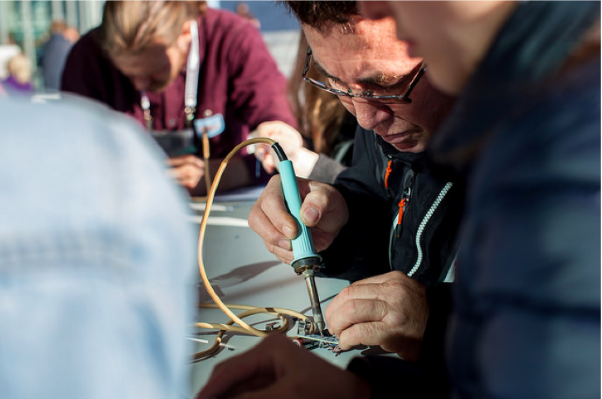
David also observed that the trend in design was a move away from designing ‘for’ the user to designing ‘with’ the user, and showed examples from the library in Tøyen, Oslo, designed with teens for teens:

He asked: Where are the library’s boundaries? Where are libraries going? How do we know? And suggested that libraries are never finished – and should never be meant to be finished, but we should always be experimenting and testing new ideas and redefining what we mean by ‘library’ in the 21st century.
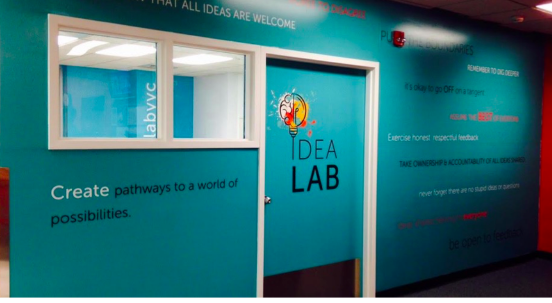
Gathering and analysing data when designing libraries
Gemma picked up where David left off to explain the importance of gathering and analysing ‘data’ when designing libraries. [Editors note: Gemma's full slide set is too large to publish here, but the images which follow are all taken from it. Please email us if you are interested in seeing it, and we'll work out a way of sharing with you.] She gave an overview of her role as a researcher at Foster + Partners, working alongside the architects to help them understand the behaviour of potential occupants so that they design buildings that support the needs and interests of these potential occupants. Librarians are also collecting data on how their customers are engaging with library services and spaces. So it comes as no surprise that architects and library professionals appear to be working together to better understand how people engage with the library today.
Drawing on her visit to large city libraries, small branch libraries, new, renovated, refurbished and extended buildings in Denmark, Finland, the Netherlands, the USA and Canada, Gemma explained that contemporary public libraries perform three main functions. They are a place for meeting, learning and reading.
- Meeting: The architects who designed the new central library in Aarhus in Denmark consider the library as ‘a place where the life of the city unfolds’. The public library has become an ‘urban office’ where freelancers and entrepreneurs work.
- Learning: The library has become a space for student-led learning. This involves taking ‘play’ more seriously as a part of childhood development. Play is also an important aspect of adulthood as it improves mental and physical health.
- Reading: The core users of public libraries still want to borrow books. They want the choice over whether they read their favourite book online or in physical format.
Library professionals are catering for a diversifying range of interests and needs which they cannot always easily satisfy – particularly in small branch libraries where there is not much space.
In some cases, they are making space for people by pushing the open stacks to the periphery of the space – and sometimes even reducing the number of open stacks altogether. Perhaps, in the future, public libraries will use off-site or high-density storage like Hunt Library, North Carolina State University, in the USA.
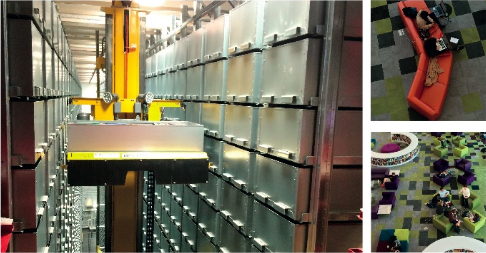
In response to the diversifying range of interests and needs of library patrons, architects are designing libraries in the following ways:
- to promote accessibility and inclusivity by designing libraries that are convenient to access and use;

- to ensure visibility and connectivity by designing libraries as places where people can freely interact;
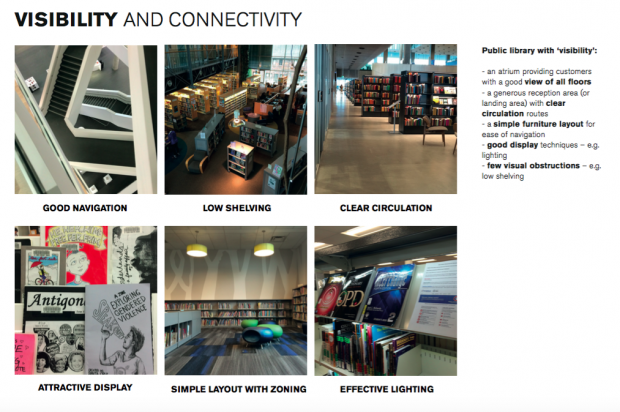
- to support flexibility and adaptability by designing libraries that can be modified to reflect people’s changing interests.
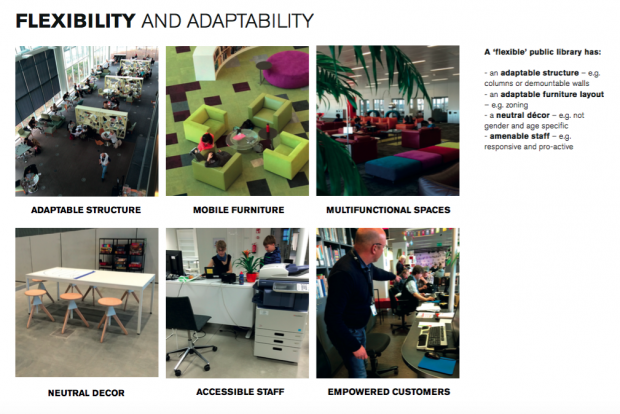
But, these new design requirements also raise new challenges, Gemma explained.
Example one: Service centres, in which public libraries are co-located with other services, are often poorly integrated.
Opinmaki is a complex in Espoo near Helsinki in Finland that houses an international school, youth department, adult learning centre, as well as a branch library. The librarians focus on creating connections between the school and the small branch library.
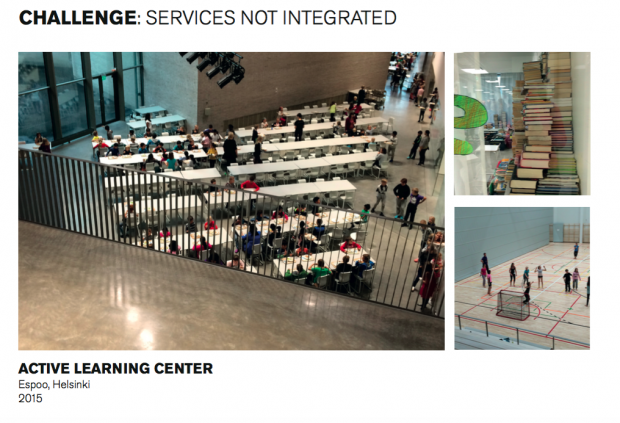
Example two: Libraries that are designed to be open – with flexible layout and mobile furniture – are potentially noisy.
The new central library in Halifax (Nova Scotia) is designed so that the noise does not travel through the building. The non-alignment of the floors creates pockets of seclusion for customers who want a quiet reading area.
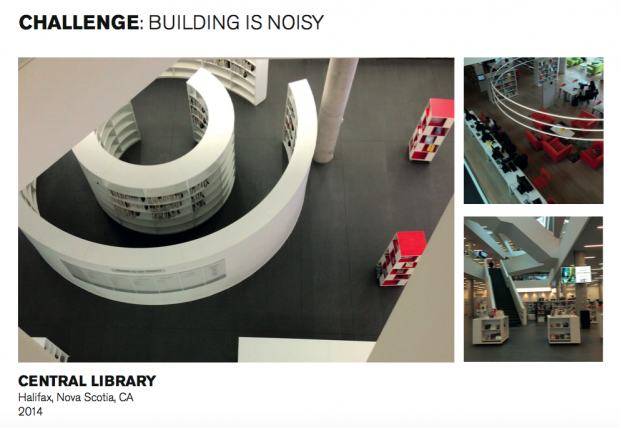
Example three: Libraries are designed to be flexible and adaptable over time to accommodate the changing needs of their customers. However, buildings with open plan spaces, flexible layout, and mobile furniture are potentially ‘messy’.
Library staff at Taylor Family Digital Library, University of Calgary, installed study carrels to create more order and to lower the level of noise.
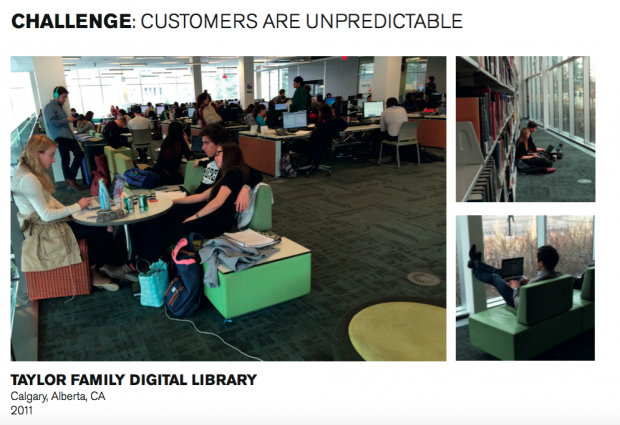
Gemma concluded her presentation by stating that there is no formula to designing libraries. The most successful libraries are those that:
- keep it real by gathering and analysing data on how their customers are using the services and spaces so that they can be improved in the interests of their community
- keep it interesting by making small improvements to the space - such as putting LED strips on open stacks to improve visibility or clearing the entrance to improve wayfinding
- keep it simple by having open plan layout, mobile furniture and neutral décor – so that customers can curate their own experiences
Discussion
The discussion after each presentation was wide-ranging, with questions falling into 3 main categories:
- Budget. Question: Delegates who are dealing with cuts to their budget asked if it is possible to redesign a library on a budget? Response: The emerging design principles are relevant at any scale and do not always require high levels of investment.
- Engagement. Comment: Delegates were disappointed by the lack of engagement between architects and library staff and customers on the design of new library buildings. Response: There should be a fluid and ongoing exchange of ideas between those managing and using the building and those designing it.
- Collection. Comment: Delegates were keen to state the importance of the collection. One delegate argued that the collection is an important way of holding onto the truth in a ‘post-truth’ era. Response: The collection is important; however, there needs to be a balance between making space for books and making space for people.
How to find out more
You can access more information about ‘designing libraries’ in the following ways:
David’s website: www.designinglibraries.org.uk and also on twitter.
Gemma’s website: www.inspiringlibraries.com (where you can download her full report) - or follow her on twitter.
If you have any views to share on this topic, please either email us or leave a comment below, and look out for our post later today, on a specific library refurbishment: the Library at Stanmore.
To keep up to date with Taskforce activities, remember to follow us on twitter, or subscribe to our blogs.
--------------------------------------------------------
Please note, this is a guest blog. Views expressed here do not necessarily represent the views of DCMS or the Libraries Taskforce